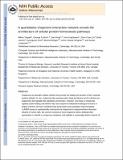A Quantitative Chaperone Interaction Network Reveals the Architecture of Cellular Protein Homeostasis Pathways
Author(s)
Taipale, Mikko; Krykbaeva, Irina; Lin, Zhen-Yuan; Larsen, Brett; Choi, Hyungwon; Gingras, Anne-Claude; Tucker, George Jay; Peng, Jian; Berger, Bonnie A.; Lindquist, Susan; ... Show more Show less
DownloadLindquist_A quantitative.pdf (3.291Mb)
PUBLISHER_CC
Publisher with Creative Commons License
Creative Commons Attribution
Terms of use
Metadata
Show full item recordAbstract
Chaperones are abundant cellular proteins that promote the folding and function of their substrate proteins (clients). In vivo, chaperones also associate with a large and diverse set of cofactors (cochaperones) that regulate their specificity and function. However, how these cochaperones regulate protein folding and whether they have chaperone-independent biological functions is largely unknown. We combined mass spectrometry and quantitative high-throughput LUMIER assays to systematically characterize the chaperone-cochaperone-client interaction network in human cells. We uncover hundreds of chaperone clients, delineate their participation in specific cochaperone complexes, and establish a surprisingly distinct network of protein-protein interactions for cochaperones. As a salient example of the power of such analysis, we establish that NUDC family cochaperones specifically associate with structurally related but evolutionarily distinct β-propeller folds. We provide a framework for deciphering the proteostasis network and its regulation in development and disease and expand the use of chaperones as sensors for drug-target engagement.
Date issued
2014-07Department
Massachusetts Institute of Technology. Computer Science and Artificial Intelligence Laboratory; Massachusetts Institute of Technology. Department of Biology; Massachusetts Institute of Technology. Department of Mathematics; Whitehead Institute for Biomedical ResearchJournal
Cell
Publisher
Elsevier
Citation
Taipale, Mikko et al. “A Quantitative Chaperone Interaction Network Reveals the Architecture of Cellular Protein Homeostasis Pathways.” Cell 158.2 (2014): 434–448.
Version: Author's final manuscript
ISSN
00928674
1097-4172